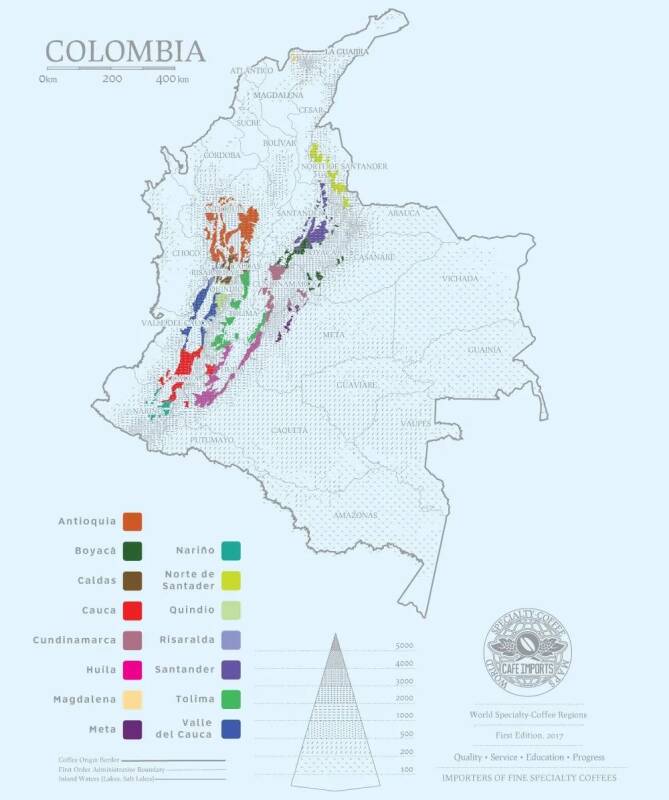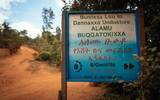In what producing areas are coffee mainly grown in Colombia? What are the characteristics of the coffee produced?
South America is the largest coffee producer in the world, producing more than half of the world's coffee each year, Brazil, which has the largest coffee production in the world, and Colombia, which is the third largest coffee producer in the world. Colombia is the world's leading producer of Arabica, but unlike large plantations in Brazil, Colombia is mountainous, dominated by small coffee farms.
Coffee is mainly grown in the Andes in west-central Colombia, which is mainly divided into the eastern, central and western Cordillera mountains, with an average elevation of more than 3000 meters, and a number of volcanoes, accompanied by high elevations and geographical environments. the whole mountain range has a variety of microclimates, which run through many coffee-producing areas in Colombia, thus shaping the unique flavor of coffee and harvesting throughout the year. Different types of coffee have matured at different periods, so Colombian coffee production is higher.
In Colombia, 32 provinces and the capital district of Bogota are divided, and 15 coffee producing areas are divided by province, of which Cauca, Santander, Antioquia, Narino, Tolima and Huila are the main coffee producing areas in Colombia.

When it comes to Colombian coffee, most people will think of El Diviso in Huilan Huila, La Roca in Tolima in Tolima, La Esperanza in Cauca in Cauca, and so on. These are the relatively well-known coffee producing areas and estates in Colombia, but the Antioquia Antioquia producing area is rarely mentioned because it is famous for its high production, but there are also many high-quality coffee producing estates in this area, such as Zacardine Manor El Zacatin.
El Zacatin, located in the town of Condordia on the southwest corner of Antioquia, is currently managed by Eduardo Fernandez and two other brothers. The estate is a family business, originally founded by the brothers' grandfather and father, and has been growing coffee for nearly 80 years.
Zakadin Manor El Zacatin can see the whole town of Concordia from the mountains of Condordia Antioquia. Coffee is planted on a hillside with an elevation of 2000-2175 meters, and a treatment plant is also set up on the mountain, which is convenient for immediate processing after harvest to ensure the quality of coffee production. At present, El Zacatin has three main farms, namely Zacatin, Illusion and La Costain. Of these three farms, about 200 hectares of land is used to grow commercial coffee beans such as Castillo Castillo.
In addition, in recent years, in order to ensure high yield and improve quality, 30 hectares of land has been allocated for planting boutique coffee varieties such as Hijaw Sidra, Java Java,Wush wush, pink bourbon Pink bourbon,SL28 and Rosa Gesha.
Although Antioquia has always been famous for its coffee production, thanks to its rich natural resources, Antioquia is located in north-central Colombia, in the mountains of the Andes, with many volcanic mountains and fertile soil. And the area is close to the Caribbean, with warm sea breezes and many rivers. The area is mainly a plateau mountain climate, with a large temperature difference between day and night, long sunshine time and sufficient rainfall, which provides a unique planting environment for coffee growth.
In addition, the region was the first area in Colombia to start growing coffee. In the 18th century, coffee was introduced to Colombia through Jesus missionaries and planted in Antioquia, and then spread throughout the country, coupled with high production. It has become an important coffee growing area in Colombia.
For more information about coffee producing areas, please scan the code directly and follow: coffee comments.
Long press the QR code to follow:
Important Notice :
前街咖啡 FrontStreet Coffee has moved to new addredd:
FrontStreet Coffee Address: 315,Donghua East Road,GuangZhou
Tel:020 38364473
- Prev

The difference between Guodin and Yejia Xuefei is Ethiopia Guodin a production area? Is Guodin produced in Kocher or Godibe?
Yirgachefe was originally part of the sub-producing area of sidamo in Ethiopia. Because the flavor of the washed coffee beans it produced was too outstanding, it later became a large producing area. Elegant white floral fragrance, bright lemon fruit flavor, fresh green
- Next

What is the definition of boutique coffee? What does coffee flavor mean? How does the flavor of coffee come from?
"This bean comes from Ethiopia in Africa, that bean comes from Panama in Central America, and this one comes from Sumatra..." I don't know if you have noticed a phenomenon, except for some well-known beans like Rose Summer, compared with other information, most baristas are introducing a bean
Related
- What effect does Italian American coffee with filter paper have? Will coffee taste better if it is put on filter paper at the bottom of the powder bowl?
- What is the color difference in coffee beans? What are the characteristics of honey processed coffee beans? Why are the anaerobically treated coffee beans uneven in color?
- How does novice Xiaobai quickly get started and make coffee? Newbies learn to make coffee by hand and share the specific steps and process process!
- Costa tea has a shelf life of 100 years?! Expert: Unable to verify
- It's a huge uproar! American milk addition was rejected by Manner employees?!
- Mocha pot coffee bean recommendations| How fine and how much powder should be used for grinding? What parameter ratios do I need to use to make milk with Mocha pot coffee?
- What are the characteristics of the world's top ten coffee beans treated with Costa Rica honey? How to make black honey kadura from Tarazhu Pilon Processing Plant taste good?
- How to make deep-roasted coffee? What grinding water temperature does authentic Jamaica Blue Mountain No. 1 coffee use to brew it well?
- Selected high-grade rose summer coffee flavor tasting guide Why Panama rose summer has the aroma of flowers and fruits
- What equipment does a novice Xiaobai need to buy to learn to make coffee? Filter cup electronic scale bean grinder manual flushing pot purchase guide

